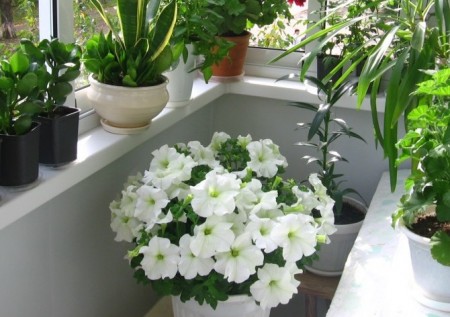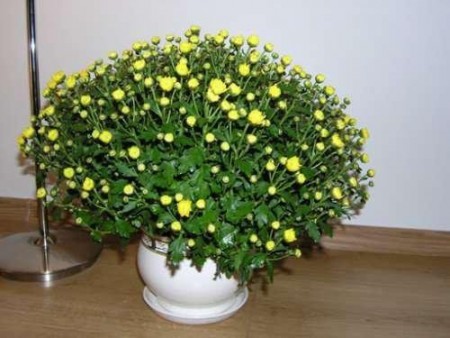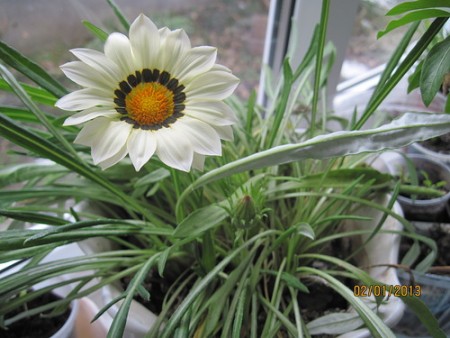If you really want to, you can probably grow any garden flower in your room. After all, our traditionally indoor plants are by no means of domestic origin: they all come from nature. This man moved them under the roof.
True, problems may arise that prevent you from growing garden flowers in the room. And there are many of them. For example, the large size of the selected plant, the need for winter dormancy.In the room, any violations of agricultural technology result in more negative consequences.
With irregular watering, chrysanthemum stems crack, leaves fall, and buds dry out. Excessive watering causes root rot in plants. Dry room air promotes the proliferation of spider mites, and humidity is favorable for fungal diseases.
An imbalance of nutrition threatens plants with chlorosis and other troubles.
But if you wish, everything can be arranged so that the plants feel almost comfortable in the room and delight you with their appearance. For example, among royal daisies (it would be more correct to call the plant magnificent cornflower) you can find not very tall varieties.
If possible, dig up a cutting of cornflower in the garden, transplant it into a pot and keep the plant on the balcony until frost. You can leave the plant on the glazed loggia for a longer time. This way the plant will quickly go through the dormant period.
Find a bright place in the room (it is advisable to organize additional lighting). In the spring, as soon as the weather permits, it is better to take the plant out into the fresh air again - to the balcony, loggia. But be prepared for the fact that the cornflower in the room will still only vaguely resemble its free relatives.
Chrysanthemums on the windowsill
Grows well in the room chrysanthemums. The easiest way is to buy a flowering bush in a store. It is grown by specialists in compliance with certain conditions that cannot be created in a room. But you can dig up a low bush in the garden, transplant it into a suitable container and bring it home.
Chrysanthemum will delight you with flowering for a long time if you can create a non-hot microclimate for the plant (no higher than 18 degrees).Short daylight hours (another condition for chrysanthemum flowering) in autumn and winter are provided naturally.
But short daylight hours do not imply poor lighting: the bush should be well lit. Water the chrysanthemums, preventing the soil in the pot from drying out. During flowering, feed with complex fertilizer for flowering plants. Spraying on the leaves will help make the air more humid and protect the leaves from drying out.
The faded chrysanthemum is cut off and taken to rest: sent to the basement or to a glassed-in loggia, if the temperature there does not drop to sub-zero levels. Cut branches can be used for cuttings. Young plants obtained from them will look more decorative than an aging bush.
In spring, the plant is transplanted into fresh soil and begins to form, pinching the tops of the shoots. They do this not only in the spring, but also in the summer, so that by the time the daylight hours shorten, they get a lush bush. On a formed plant, the flowers do not stick out alone on long shoots, but “bathe” in the greenery of the leaves.
Annuals can also grow indoors
It is not difficult to grow garden flowers in a room, which in our country are considered annuals, but in essence are still perennials: salvia, petunia, cineraria maritima, Snapdragon, lobelia. Gatsania It may well replace tall nivaria.
If you carefully dig up a compact bush before frost and transplant it into a pot, gatsaniya will delight you with its spectacular daisy flowers for a long time. You just need to find a sunny place for it, water it, feed it and trim off the faded inflorescences.
Petunia grandiflora can be grown as a houseplant.To make it look neat, shoots that begin to stretch out are regularly cut off and fed. The gorgeous flowers of large-flowered petunia in the room will look more flawless than in the flower garden, since they are not torn by the wind.
A snapdragon transplanted into a pot can also bloom almost continuously. Lobelia is also one of the “tireless” flowers. Its thin shoots, gracefully falling from the pot, are studded with tiny, but so cute flowers.
Flowering bulbous plants will bring a lot of joy in winter or early spring: hyacinths, daffodils, tulips, crocuses, muscari. You just need to plant the bulbs in containers and store them until sprouts appear in the basement, on the loggia, where it is cold, but still not frosty.
Now in stores you can buy lily bulbs that have already passed the cooling period. They are planted and immediately left in the room where they will begin to grow and bloom.
On a sunny kitchen window it is appropriate to “plant a useful flower garden”: small-fruited bitter peppers, green and purple basil, curly parsley. In a word, your desire to have garden plants at home is quite feasible.





 CUCUMBERS NEVER GET SICK, I'VE BEEN USING ONLY THIS FOR 40 YEARS! I SHARE A SECRET WITH YOU, CUCUMBERS ARE LIKE THE PICTURE!
CUCUMBERS NEVER GET SICK, I'VE BEEN USING ONLY THIS FOR 40 YEARS! I SHARE A SECRET WITH YOU, CUCUMBERS ARE LIKE THE PICTURE! You can dig a bucket of potatoes from each bush.Do you think these are fairy tales? Watch the video
You can dig a bucket of potatoes from each bush.Do you think these are fairy tales? Watch the video
 How our fellow gardeners work in Korea. There is a lot to learn and just fun to watch.
How our fellow gardeners work in Korea. There is a lot to learn and just fun to watch. Eye trainer. The author claims that with daily viewing, vision is restored. They don't charge money for views.
Eye trainer. The author claims that with daily viewing, vision is restored. They don't charge money for views. A 3-ingredient cake recipe in 30 minutes is better than Napoleon. Simple and very tasty.
A 3-ingredient cake recipe in 30 minutes is better than Napoleon. Simple and very tasty. Therapeutic exercises for cervical osteochondrosis. A complete set of exercises.
Therapeutic exercises for cervical osteochondrosis. A complete set of exercises. Which indoor plants match your zodiac sign?
Which indoor plants match your zodiac sign? What about them? Excursion to German dachas.
What about them? Excursion to German dachas.